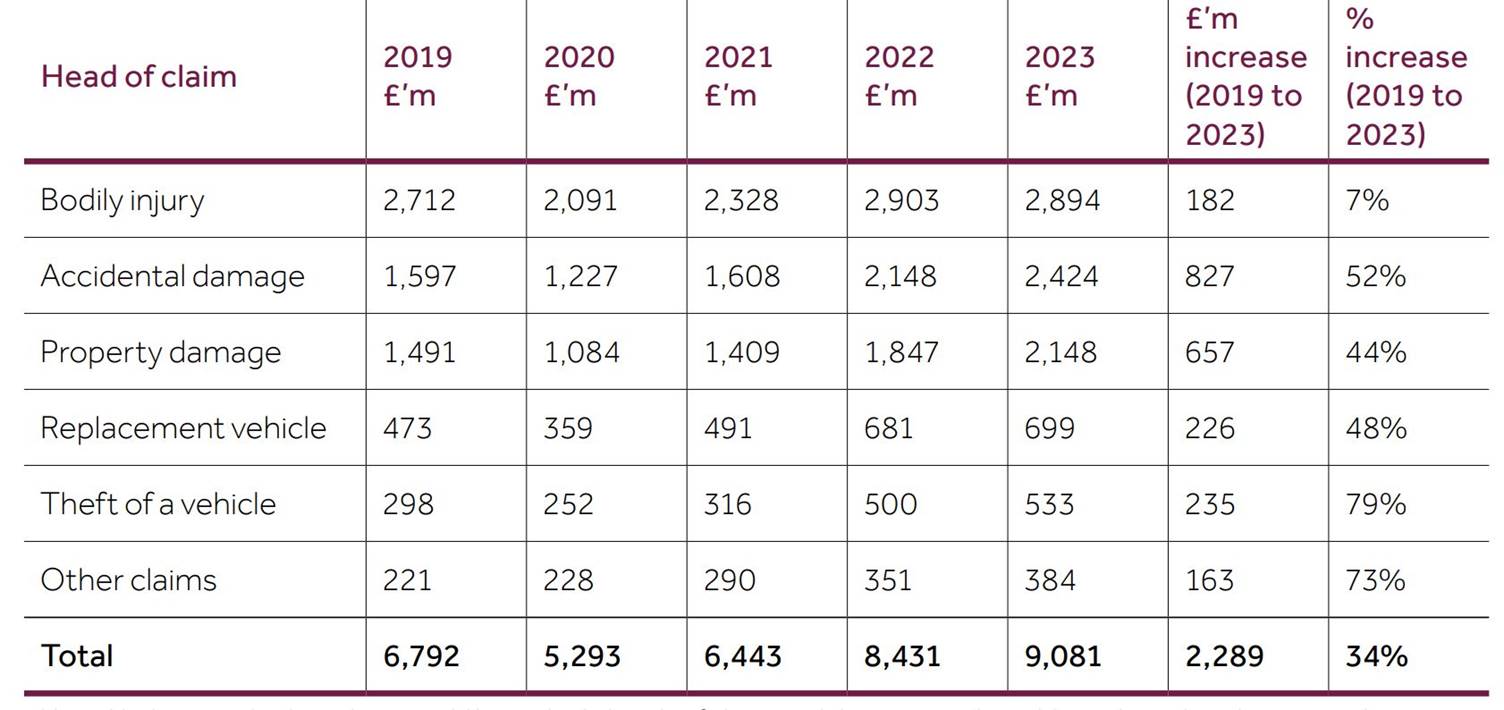The MSC Ruby is almost ready to leave Felixstowe. Seven remote-controlled gantry cranes are still at work, stacking containers in the ship’s bays. Some 11,000 containers pass through this port each day, making it Britain’s primary conduit to the arteries of global trade. The Ruby’s next call is Gran Canaria—then, the long run down the coast of Africa. Watching the scene, Adam Gibson, the lone police officer at the port whose job is finding stolen cars, sounds rueful: “There’s no way in hell I can search even a small fraction of them. We could be standing here now and there could be three or four boxes of stolen cars just there in those stacks. They could be manifested as teddy bears.”
The Economist August 17th 2025
This is one factor driving claims inflation and it is accelerating so what should insurers do to prevent this? I discuss this in the following sections: -
- Motor Claims Analysis
- Why is it easy to steal autos in the UK?
- What is to be done about it and whose responsibility?
- It is not just autos- phones and farm equipment are targeted by criminal gangs
- Further Reading
1 Motor Claims Analysis
The Financial Conduct Authority (FCA) July 2025 report ‘Motor Insurance Claims Analysis) showes the value of car theft claims increasing by 79% over the period 2019 to 2023. Theft may only be 6% of total claims value over the period but it the fastest growing category.

Source: FCA
The Economist states that the volume of car thefts in Britain has increased by 44% in the period 2020 to 2024.
Claims inflation caught many British insurers with their underwriting pants down in 2023 as combined operating ratios (COR) declined and EY has warned that after a profitable 2024 the adverse COR scenario will return in 2026 with only breakeven in 2025. ( See further reading)
2 Why is it so easy to steal cars in the UK?
Firstly there is a massive market in West Africa for SUV's and sports cars and an efficient logistical chain operated by the thieves, often stealing to order, the supply chain organisers having cars in containers for export within 24 hours of theft, and delivery to buyers with money transfer technology within days.
There are only three police officers across the whole south of England to locate and identify stolen cars and border control authorities, already stretched by limitd resources, are focussed on imports rather than exports. The authorities at ports in West Africa and China are equally lax in discovering stolen goods in arriving containers where the documentation seems bona fide.
For every advance in security built in by auto OEMs criminal gangs develop new techniques and exploit new technology. Now thieves are more likely to get in by plugging a device directly into one of the car’s electronic components, which tricks the car's tedchnology stack into thinking it is being contacted by a smart key. Adam Gibson, the police officer at Felixstowe port quoted above, points to several cars he has recovered that have been broken into using this technique: one via the tail-light, another via a component next to the bonnet latch.
The kit for this can be easily bought online. Videos on YouTube even explain how to use it. Most thefts are carried out by organised criminal groups, which will invest as much as £20,000 ($27,000) on a single piece of equipment. A police force says that, when it confiscated such a device, it bought only a quiet couple of weeks.
Much is written today of the need for faster innovation and it looks like criminal gangs have taken that to heart rather than auto OEMs and insurers. Autos take years to design, develop and launch. One a criminal gang finds an entre via a tail-light, component next to the bonnet latch or elesewhere they have years to exploit the hacking point into the auto tech stack.
Criminal groups combine covert communications, transportation logistics and money transfer to power a lucrative trade with, currently, little chance of being caught. Once on the high seas the car is lost to any effective claim.
3 What’s to be done about it?
Who is most responsible?
- The insurer?
- The insured?
- Auto OEMs?
- The Government and its agencies?
It is all parties and if insurers are to prevent risk rather than just pay out claims and raise premiums they must work with all stakeholders.
Educate customers to take all precautions and reward those that do. How many customners still leave remore car fobs near the front door open to digital theft?
Work with auto OEMs to increase security leveraging vehicle technology stacks and tracking devices in competition with criminal gangs leveraging new technologies. to attack these same targets.
Collaborate with Border Agencies, the Police and HMG to have more agents investigating criminal gangs, inspecting containers and catching stolen cars before they are exported.
Is this a short-term strategy? Unfortunately, not, but without the hard yards put in now car thefts will only accelerate and claims inflation increase yet more.
As the costs of theft are socialised, via higher insurance premiums—theft is often a problem that no one has a strong incentive to fix. But should that really be the case?
4 It is not only autos though?
London is tagged the ‘phone theft capital of the world’ - over 40% of phones stolen in Europe according to The Economist . Most end up in Shenzen, China, at Huagiangdei Market which is the world’s largest electronic’s market. Unlocked phones are stolen to order, locked ones served by logistic experts in the criminal gang supply chain who unlock them, and the tough ones to crack are broken down into spare parts.
Just as criminal gangs speedilily innovate the theft of autos, so to do they adapt to manufactuers' phone security measures. The introduction of biometric locking and face identification made it harder for thieves to get into locked phones, rendering them less valuable. The response was a surge in “snatch thefts”, whereby thieves yank an unlocked phone from someone’s hand, and then disable tracking before the victim can report it lost.
Jerusalem is the hymn played with fervour at the end of the Proms series of concerts held at the Albert Hall in London during August. One verse refers to “England's green and pleasnt land” but in that rolling countryside British farmers are plagued by raiding gangs. Their tractors and GPS kits usually head east, to Russia or eastern Europe in the same way autos head to Africa.
For centuries criminals have nicked valuable products and smuggled them across borders, beyond the reach of the law. Britain today shows how this model has evolved in new and alarming ways. Encrypted communications have enabled criminal gangs to operate and co-operate more freely than ever before, and establish global supply chains. As countries in Africa and Asia have become richer, demand for the products common on the streets of the rich world is growing. This combination has spawned a flourishing criminal enterprise. Call it Grand Theft Global Inc.
Fraud and Cyber security threats are an increasing threat to insurers whilst the criminal gang targetting of autos, phones and farm equipment combine both the leveraging of technology and old fashioned theft combined in a new wave of customer and insurer loss.
Many a tale of the wonders of AI describe a scenario where a roadside accident triggers the auto's technology stack to immediately detect and confirm damage, enable the driver to warn of injury and triage the attendance of emergency services, roadside assistance and recovery of the vehicle with parallel organisation of repair and /or replacement.
So why cannot Auto OEMs and Insurers innovate faster to counter the theft descibed above? The auto tech stack to Identify criminal gang access, flag theft to police, insurers and transmit location. Adam Gibson the lone policeman at Felixtowe container port will be a happier man.
5 Further Reading
The new geography of stolen goods The Economist
Gangs are using increasingly sophisticated kit to steal cars The Economist
UK motor insurers expected to only break even this year and dip into the red in 2026 EY June 2025 study
Motor premiums fall - but repair and theft costs keep revving up claims ABI report
Motor Insurance Claims Analysis FCA July 2025
Are UK Motor Insurers chasing volume growth at the expense of forfeiting future competitive advantage? Insurtech World
Without many people noticing Britain has become a leading exporter of stolen goods. In the past decade the number of vehicles stolen in the country has risen by 75%. Most end up on container ships; the top destination is west Africa. More recently London has become known as the “phone-snatching capital of Europe”. If the victims manage to track their devices, the goods are most likely to turn up in China. British farmers are plagued by raiding gangs. Their tractors and GPS kits usually head east, to Russia or eastern Europe.
 unknownx500
unknownx500









